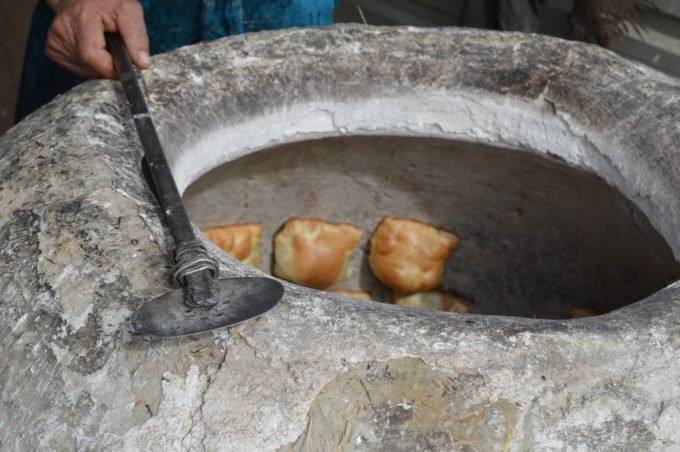
The Best Little Silk Road‑Side Samsa Stand in Uzbekistan

The Best Little Silk Road‑Side Samsa Stand in Uzbekistan
Samsa in the Kyzylkum Desert
It’s hard to keep track of time when you’re driving through the desert. Though it’s early spring and we are spared, luckily, the scorching Central Asian heat as we make our way through Uzbekistan’s Kyzylkum Desert, the landscape still exerts a powerful pull on our thoughts. It’s not empty; scrubby bushes dot the flat brown vista, stretching for miles in every direction. Occasionally, there are hills.
It’s easy to imagine camels on this road. Even more so because we saw one, confidently strutting in the desert as we passed. With the way the asphalt is pocked and scarred, camels are probably better suited for this road than our Uzbek-made Chevrolet (locally-manufactured Chevrolets, usually white to ward off the unforgiving heat, are ubiquitous all over the country).
Go pretty much anywhere between Turkey and China, and you’ll find that most places claim to be along the ancient Silk Road, that magical bridge between West and East. Perhaps nowhere is this more true, however, than on the dusty highway we’re now on, a few miles from the Karakum Desert across the border in Turkmenistan, en route to Bukhara, an ancient Silk Road trade center.
Some hours later, our driver stops the car, telling us in a mix of Tajiki and Uzbek that he wants us to try something. We’ve arrived at a stand in the desert, made of corrugated aluminum with columns of wood to hold it up. A sign in Cyrillic tells us the place serves “Tendir Samsa”. A large, cylindrical clay oven, the tendir in all its glory, confirms this.
Torsun, the grizzled man who runs the stand and lives here, off the highway, removes the cover of the tendir to reveal square-shaped pockets of dough stuck to the inside. They are crisp and brown at the edges. The smell that wafts from the oven is savory, like fried onions. Suddenly we realize we are hungry.
Torsun carefully detaches each samsa with a metal spatula and fine colander-like metal net. Encouraged by our driver, we grab the samsas with both hands. One bite into the crisp exterior and the hot, oily juices come pouring out into the bowls under us. Inside, there are gristly bits of meat laced with fat, onions, and herbs. It is delicious.
Our driver pulls up plastic stools, and Torsun insists we sit. We eat more samsas, drizzling them with a slightly spicy tomato chutney-like sauce and washing them down with green tea in bowl-style Uzbek cups. We exchange some words, but mostly, we eat.
Uzbek samsas, unlike their South Asian cousins, are never fried, only baked in the tendir. They are a humble meal, available in every town. The tendir ovens are even portable, though they don’t look it, which makes Torsun’s choice of location seem rather strange. His stand isn’t the only place to eat on the road to Bukhara, but it just might be the most remote.
A380 Highway,
50 km from Bukhara
No opening/closing hours